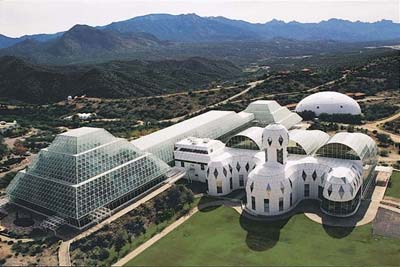The Key to IoT Ecosystems: Design
Without giving nightmarish flashbacks to junior high science class, I want to talk a little bit about ecosystems – don’t worry, I won’t go into detail about decomposition and inorganic matter. I do, however, wish to address the ecosystems that are constantly heard of in the IoT space.
New partnerships and alliances come together on a daily basis creating headlines aimed to bring attention to the real momentum behind the rush to connecting everything around us, and do so in a way that is able to scale and support growth. In our industry, that growth would commonly look like a growing number of connected devices in the world delivering business and personal benefit.
 So, while many healthy ecosystems do exist, there are a few science projects that may resemble the infamous Bio-Dome (yes, the actual one that put Pauly Shore on the map, kind of…). The Bio-Dome was constructed in central Arizona during the late 80’s on three acres of desert landscape. The facility would contain grasslands, ocean waters, and even rainforests. Eight scientists were then sealed in to live. This $200 million experiment was supposed to be a breakthrough for sustainability research. The reality was that it was a very poorly designed project that is known as one of the great failures in ecosystem research. The scientists within the Bio-Dome began to fight, oxygen levels decreased significantly, and in the end, the project was terminated.
So, while many healthy ecosystems do exist, there are a few science projects that may resemble the infamous Bio-Dome (yes, the actual one that put Pauly Shore on the map, kind of…). The Bio-Dome was constructed in central Arizona during the late 80’s on three acres of desert landscape. The facility would contain grasslands, ocean waters, and even rainforests. Eight scientists were then sealed in to live. This $200 million experiment was supposed to be a breakthrough for sustainability research. The reality was that it was a very poorly designed project that is known as one of the great failures in ecosystem research. The scientists within the Bio-Dome began to fight, oxygen levels decreased significantly, and in the end, the project was terminated.
So, what went wrong? And, more importantly, what does this have to do with the Internet of Things?
Both questions can be drawn back to design. Let’s start with what went wrong. Three major problems quickly made their way into the dome.
- Insufficient Air – The dome was sealed off and within 18 months oxygen started to be pumped in to keep the scientists alive. It turns out that plant life did a great job using Carbon Dixoide, but so did elements within the concrete walls. Untreated, those walls took the Carbon Dioxide and turned it into a calcium salt – great for heartburn, but not so good for breathing.
- Extinction – Designed to be the right balance, the man-made environment proved to be slanted to heavily in favor of some plants and insects, causing some species of plants and insects to thrive, while others were subsequently choked off.
- Too Many Nutrients – Have you ever heard of something having too many nutrients? Well, that’s what happened here and it isn’t a good problem to have. The scientists struggled to get the right balance back in the water.
Interestingly, the Bio-Dome, despite its failures, serves as an important lesson in ecosystem design. We can learn much from this case study as companies throughout the IoT world are constructing ecosystems designed to bring and sustain life to the biggest explosion of technology that the world has ever experienced.
So, to help us answer the second question: “what does this have to do with IoT?” Let’s make some parallels to the design of that infamous Bio-Dome.
- Insufficient Air – There are two elements of IoT solution design that come to mind on this subject: throughput and capacity. Right from the beginning, it is critical to understand the data demands of a solution. For example, a home security solution requiring video and voice will have no place using many of the LPWA technologies. Similarly, if you ever wish to communicate with the deployed device in the field, maybe change a setting or perform a firmware update, don’t use a technology that only has one-way communication capabilities. Capacity is also an area that will soon rear its head as more and more IoT devices flood networks. Choose a network with ample capacity.
- Extinction – Network technologies will always be slanted toward the highest paying customer. Cellular technologies show this off every few years with the sunset of one technology to feed the growth of a newer, faster technology. LTE is a prime example of this. Leaving in its wake the shutdown of 2G, and eventually 3G, IoT devices face a tough design question of where to turn for low cost connectivity that can be counted on for more than the next network evolution.
- Too Many Nutrients – How can this be? Well, in the world of IoT ecosystems this design problem is beginning to manifest itself in the form of overgrown partner ecosystems that promise results without delivering them. Alliances and partnerships are taking place with as little as a handshake, leave businesses and application developers on their own to figure out the integration problems that should be solved before any announcements are made.
While the Bio-Dome in many ways couldn’t be any more disconnected from the Internet of Things, the lessons in its design are actually quite applicable, because in the end, the success/failure of IoT-related companies will come down to simple design. To quote the arguable master of design himself, Steve Jobs: “Design is a funny word. Some people think design means how it looks. But of course, if you dig deeper, it’s really how it works.”





 SDxCentral – November 29, 2016 – Non-cellular low-power wide area (LPWA) networks like Ingenu and
SDxCentral – November 29, 2016 – Non-cellular low-power wide area (LPWA) networks like Ingenu and  Tweak Your Biz – November 28, 2016 – The Internet of Things (IoT) has a reputation for being something that only large companies can capitalize on. However, in reality, the growing realm of connected technology has the power to provide invaluable customer insights to even the smallest businesses.
Tweak Your Biz – November 28, 2016 – The Internet of Things (IoT) has a reputation for being something that only large companies can capitalize on. However, in reality, the growing realm of connected technology has the power to provide invaluable customer insights to even the smallest businesses. CNX Soft – November 20, 2016 – I’ve recently started to write a bit more about long range LPWAN standards for IoT applications, especially
CNX Soft – November 20, 2016 – I’ve recently started to write a bit more about long range LPWAN standards for IoT applications, especially 
 PR Web – November 16, 2016 – With potential savings of 80 percent, wireless sensors are becoming the default option for oil and gas remote monitoring, according to a recently published study by ON World.
PR Web – November 16, 2016 – With potential savings of 80 percent, wireless sensors are becoming the default option for oil and gas remote monitoring, according to a recently published study by ON World. EIN Newsdesk – November 14, 2016 –
EIN Newsdesk – November 14, 2016 –  IoT Business News – November 14, 2016 – u-blox demonstrates commitment to the IoT with new RPMA module for LPWA applications and LTE Cat 1 modules with global network support.
IoT Business News – November 14, 2016 – u-blox demonstrates commitment to the IoT with new RPMA module for LPWA applications and LTE Cat 1 modules with global network support. 
 ReadWrite – November 14, 2016 – Cold chains are the hidden lifeline of much of the modern world. A cold chain is the sequence of cooled storage and refrigerated transport which keep produce fresh, vaccines viable, and families fed. This often requires very precise controls. For vaccines, a sensitive product, the cold chain is carefully crafted to maintain temperatures
ReadWrite – November 14, 2016 – Cold chains are the hidden lifeline of much of the modern world. A cold chain is the sequence of cooled storage and refrigerated transport which keep produce fresh, vaccines viable, and families fed. This often requires very precise controls. For vaccines, a sensitive product, the cold chain is carefully crafted to maintain temperatures